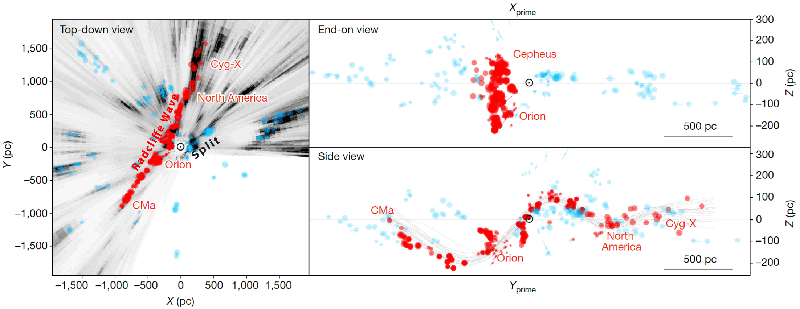| EPoS Contribution |
|
The Radcliffe Wave and the new view on the Local ISM
Joao Alves U Vienna, Vienna, AT | |
| The current model for the structure of the local Milky Way is in crisis. Data from the ESA Gaia mission has overthrown the 150-year-old paradigm for the gas distribution in the local Milky Way, a 500 pc ring known as Gould’s Belt. In the newly emerging view, local star-forming regions are connected by lower-density gas. They are part of a new organizational unit: undulating, coherent, and linear Galactic-scale gas structures. We recently found that the Sun lies about 100 pc from a ~3 kpc such structure we named the Radcliffe Wave. In this talk, we will discuss the origin of these kpc-long structures, our attempts to measure their 3D dynamics, how GMCs and star-forming regions form inside these structures, and the relation between the Radcliffe Wave and the Local (Orion) spiral arm. | |
 | |
| Caption: 3D distribution of local clouds. The position of the Sun is marked with $\odot$. The size of the symbols is proportional to the column density. The red points describe a spatially and kinematically coherent structure that we term the Radcliffe Wave. The greyscale map in the left panel shows the Green et al. 2019 dust map (-300 pc < Z < 300 pc), which indicates that our sample of cloud distances is essentially complete. The right panels show projections in which the X-Y frame has been rotated anticlockwise by 33° (top, Xprime-Z) and clockwise by 120° (bottom, Yprime-Z) for an observer facing the Galactic anti-centre. The 1σ statistical uncertainties on the distance are represented by line segments that are usually smaller than the symbols. For an interactive version of this figure, including additional layers not shown here (for example, a model of the Gould Belt and log-spiral arm fits), see here (may take a moment to load). | |
| Collaborators: C. Zucker A. Goodman J.S. Speagle S. Meingast T. Robitaille D.P. Finkbeiner E.F. Schlafly G.M. Green |
Key publication
Suggested Session: Galactic Dynamics & SF |

